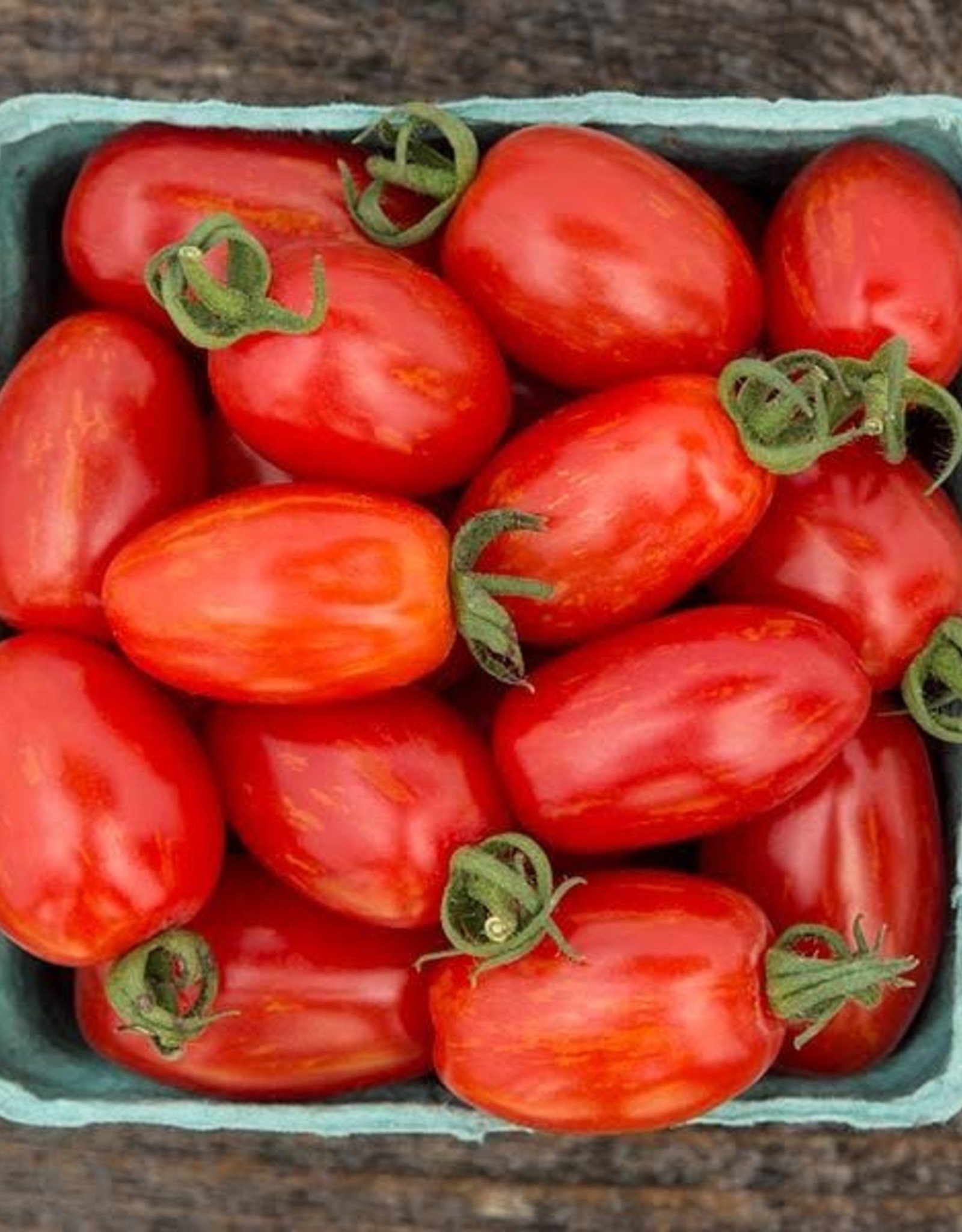HM Supernova Cherry Tomato 1/10 G
| Availability: | In stock (6) |
Photo and Description Credit: High Mowing Seeds
Days to Maturity: 63 days
A marbled mini-Roma shape with constellations of yellow stripes on a red flesh background.
Truly the standout in our star-studded grape tomato collection, Supernova impresses with both aesthetics and flavor. Red flesh with yellow marbeling inside and out, and a unique mini-Roma shape. Fruit holds well through transport. Part of High Mowing's exclusive Galaxy Suite tomato collection bred by Phillip Griffiths of Cornell University. A portion of the sales of this variety is paid to the breeder - learn more here.
- HMOS EXCLUSIVE
- Indeterminate
- .25-.5 oz
- BR
- Open-Pollinated
Cultural Info
Tomatoes (Lycopersicon esculentum) are warm season tender annuals in the Solanaceae family which includes eggplants, peppers, tomatillos, potatoes and ground cherries.
- Indeterminate varieties bear fruit over a long period of time and typically require trellising or staking.
- Determinate types have a concentrated fruit set and a shorter growth habit, therefore don’t require trellising.
Soil Nutrients and Requirements
Tomatoes yield best in clay or loam soils that are well drained and high in organic matter. They can tolerate acid soil as low as 5.5, but they prefer to grow in 6.0-6.8 range. Using calcitic lime or gypsum can help to maintain a base saturation for calcium or 65-80 percent. Use a high phosphorus fertilizer for transplants. Take care not to over-fertilize with Nitrogen as this can result in more foliage but lower yields.
Seeding Depth
Planting depth: 1/8-1/4".
Plant Spacing
Plant spacing: for determinate varieties 12-18", for indeterminate 24-36".
Row Spacing
4-6’ centers. Greenhouse Tomatoes- maintain 4 square ft/plant.
When to Sow
Days to maturity are from transplants. Start seeds 6-8 weeks before planting date. Optimal soil temperature for germination is 75-85°F; seeds in colder situations will germinate very slowly. Do not start too early; transplants will suffer if allowed to become root bound and leggy. Harden off transplants by reducing water and nitrogen fertilizer. Transplant outdoors after danger of frost has passed.
Other Considerations
- Black plastic is recommended is cool climates especially to help warm the soil, keep moisture even and cut down on weed pressure and soil borne diseases.
- Floating row covers can provide extra warmth in the early season, but be sure to remove when temps are warmer than 85 degrees.
- For varieties requiring staking, place stake in row every two or three plants, tie twine to end stake and walk down one side of the row, looping twine around each stake until the end. Return down the other side of row, again looping twine around each stake, so that plants are sandwiched between two sides of twine.
Harvest
Harvest tomatoes fully ripe for best flavor. Tomatoes can also be harvested green or at first blush and ripened off the vine at temperatures above 70°F.
Storage
Store between 55° - 70°F at 95% relative humidity. Storing below 50°F can result in chilling damage.
Pest Info
- Hornworms-Hand pick larvae. Populations are usually controlled naturally.
- Aphids can be washed off plants with a hard stream of water. They have several natural predators that control populations including parasites (aphids appear grey or bloated), lady beetle larvae and lacewings.
- Whiteflies- Check any purchased plants for signs before bringing them home. Eggs are laid on the underside of leaves in a crescent or circle. Insecticidal soap can help. Lady beetle larvae, lacewing, parasitic wasps and songbirds all feed on whiteflies. A hard freeze will also kill them.
- Colorado potato beetle (CPB) – While Bacillus thuringiensis var. tenenbrionis. is effective against CPB and was formerly the easiest insecticide to use, the current formulations have been removed from OMRI-A status due to difficulties with assessing inert ingredients. Luckily there is a new addition to the arsenal in the form of spinosad (such as Entrust™). Spinosad works rapidly and effectively against CPB, as well as against corn earworm, imported cabbage worm, codling moth, and several other difficult lepidopterous pests. Ideally we will regain access to Bt so that these two formulas can be used in rotation with one another to prevent selection of resistant insects. Crop rotation, control of solanaceous weeds, barrier trenches between old and new plantings, trap cropping, use of straw mulch or row cover can delay or reduce CPB pressure.
- Cutworms- Usually only a problem for young transplants, placing a collar around the stem when plants are set out will protect them.
- Flea beetles- Floating row cover can protect plants. Be sure to remove when temps are warmer than 85 degrees.
Disease Info
- The most problematic disease for tomato growers in the Northeast, Mid-Atlantic, and Midwest is early blight, caused by Alternaria solani and Alternaria alternata in cooperation with Septoria lycopersici. Early blight is best treated early with regular applications of fungicidal sprays such as oxidate and/or copper hydroxide.
- Field tomatoes are also subject to several common diseases that affect fruit quality, such as bacterial speck (Pseudomonas syringae pv. tomato) and anthracnose (Colletotrichum coccodes). Symptoms include black spots on the fruit; the size (less than 2 mm) distinguishes bacterial spec from bacterial canker and bacterial spot, two other bacterial diseases which case larger fruit spots. The best prevention for all bacterial diseases is to use disease-free seed and to avoid contact with plants during moist conditions.
- Bacterial canker (Clavibacter michiganensis subsp. michiganensis) has become more common in recent years with the increase in greenhouse tomato operations. The most distinctive symptom of are raised, light tan, “birds-eye” cankers, no more than 3 mm in size. Diseased plants should immediately be removed and destroyed to prevent spread. Most sprays are largely ineffective and can serve to spread the disease.




